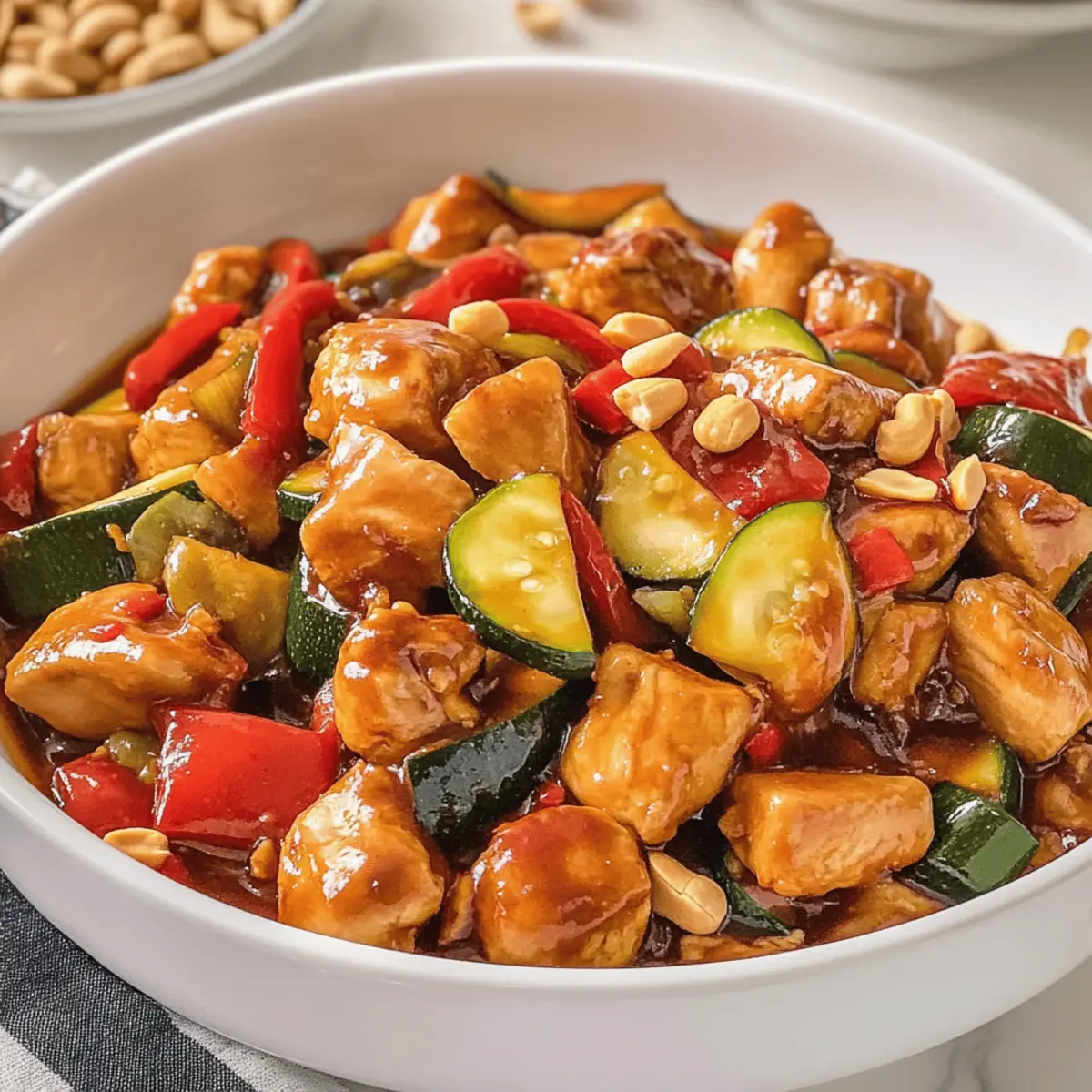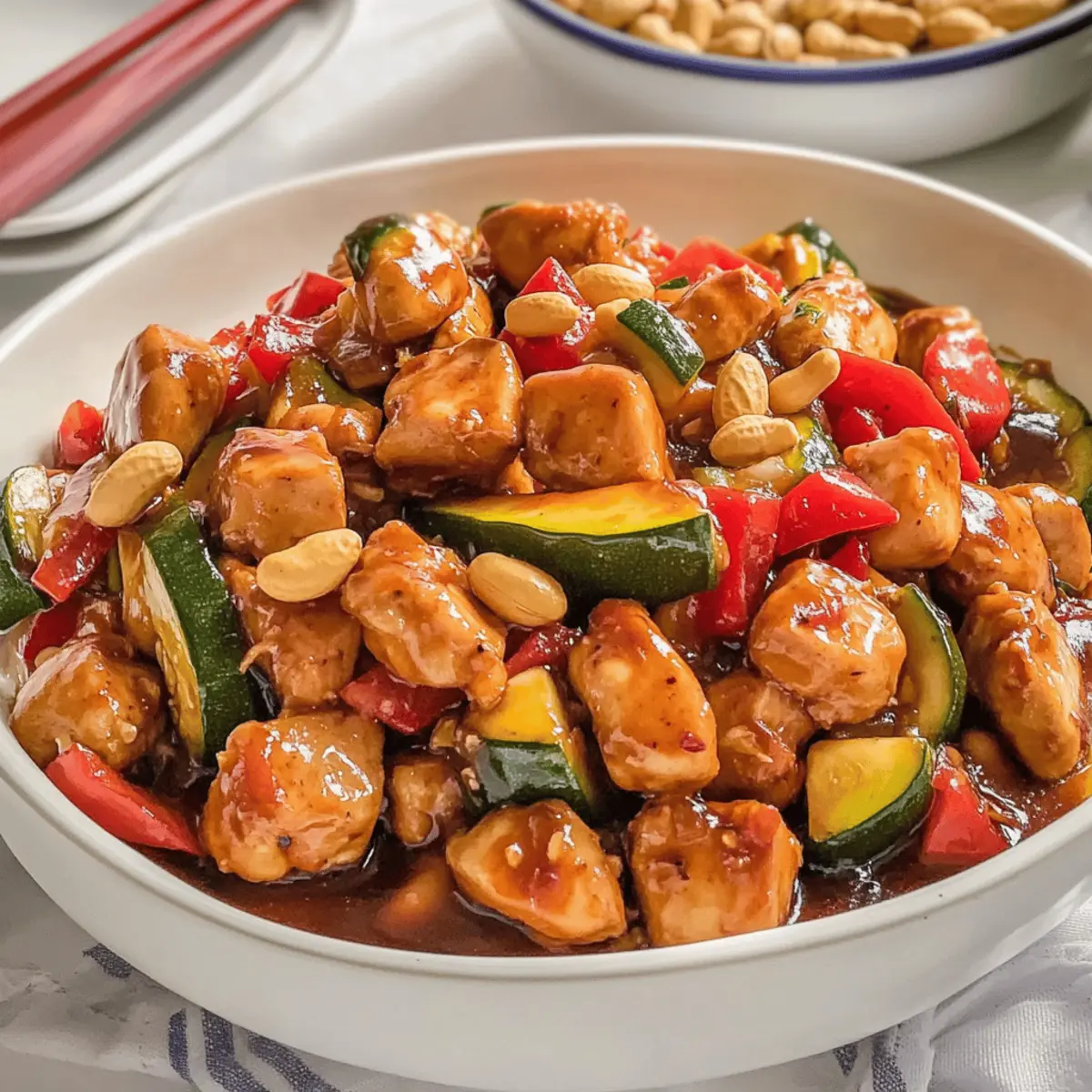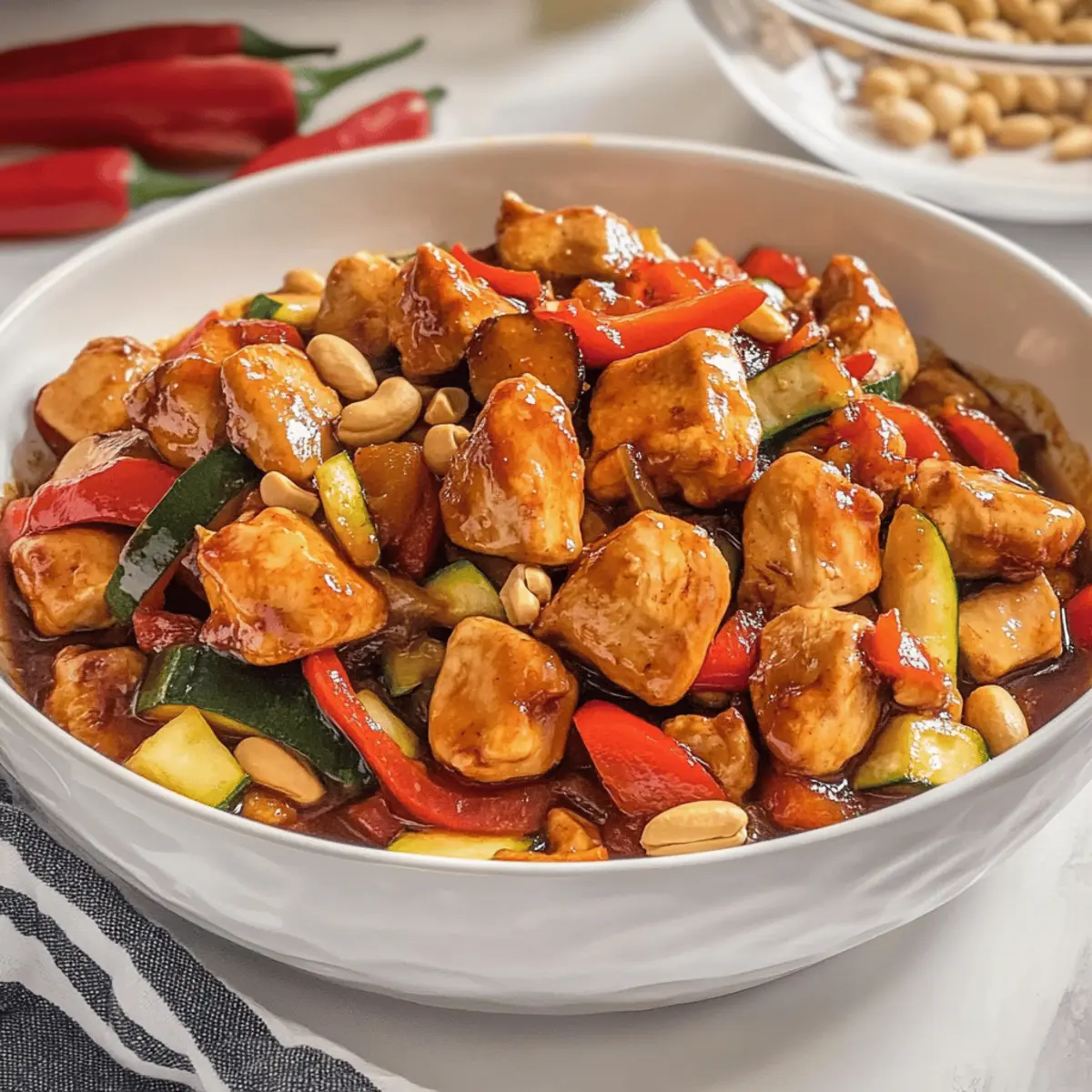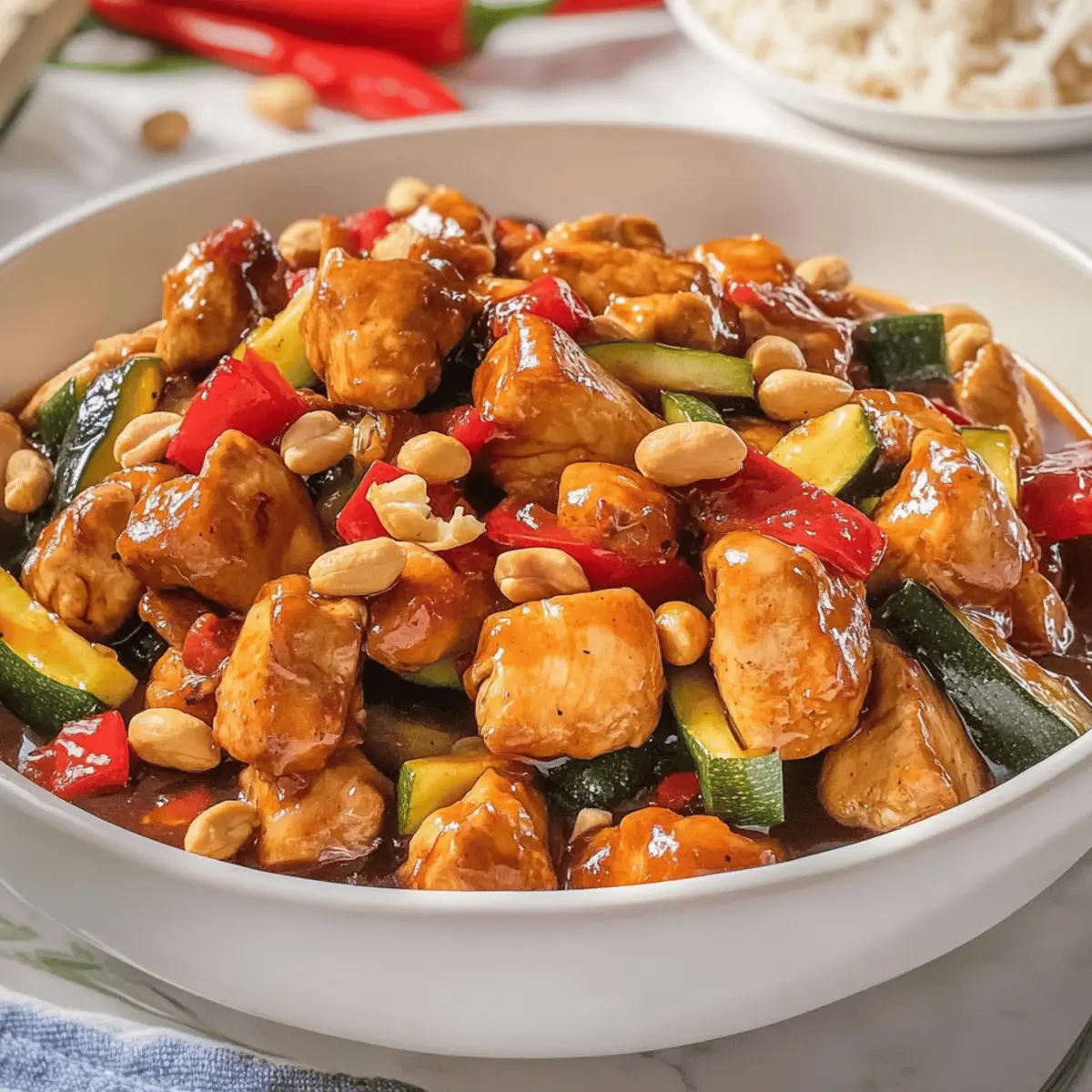As I was stirring my sauté pan, the tangy aroma of ginger and garlic wafted through my kitchen, instantly igniting my appetite. This Better-than-Takeout Kung Pao Chicken is more than just a meal; it’s a culinary hug, featuring tender chicken breast, crisp vegetables, and crunchy peanuts enveloped in a glossy, savory sauce. Perfect for those busy weeknights, this dish comes together in just 25 minutes, making it an incredible option for anyone exhausted by fast food choices. Not only is it high in protein, but it’s also customizable with your favorite vegetables, ensuring everyone gathers around the table for seconds. Are you ready to discover how quick and flavorful homemade can truly be? Let’s dive into this delightful recipe!

Why is Kung Pao Chicken Amazing?
Quick Preparation: This recipe comes together in just 25 minutes, perfect for those hectic weeknights!
High Protein: Packed with protein from tender chicken, it’s a filling meal without the takeout guilt.
Flavor Explosion: The tangy sauce, combined with aromatic garlic and ginger, creates a delicious symphony of flavors that dance on your palate.
Customizable Goodness: Feel free to add your favorite veggies like broccoli or snap peas for a nutritious touch. You can even try it with tofu for a delightful vegetarian option!
Crowd-Pleaser: Your family and friends will love this comforting dish, making it an instant favorite at your dinner table. If you’re looking for more easy meals, check out our Garlic Parmesan Chicken for another crowd-pleaser!
Kung Pao Chicken Ingredients
For the Chicken
• Chicken Breast – 1 lb cut into 1-inch pieces; a lean protein base for your Kung Pao Chicken.
• Light Soy Sauce – 1 tablespoon; adds essential umami flavor to the marinade.
• Shaoxing Wine – 1 tablespoon; infuses depth of flavor; can be replaced with dry sherry if needed.
• White Pepper – ¼ teaspoon; provides a subtle heat.
For the Marinade & Sauce
• Cornstarch – 2 teaspoons (for marinade) & 2 teaspoons (for sauce); thickens your savory glaze.
• Granulated Sugar – ½ teaspoon for marinating + 1 tablespoon for the sauce; balances the dish’s flavors.
• Oyster Sauce – 1 tablespoon; enriches the sauce with umami richness.
• Dark Soy Sauce – 1 tablespoon; gives the sauce a rich color and deeper flavor.
• Chinese Black Vinegar – 1 ½ tablespoons; adds tanginess and flavor complexity.
• Sesame Oil – 1 teaspoon; lends a nutty aroma to your dish.
• Low Sodium Chicken Stock or Water – ⅓ cup; forms the base of your luscious sauce.
For the Aromatics
• Garlic – 4 cloves, minced; an aromatic that enhances flavor.
• Ginger – 1 teaspoon, minced; adds freshness and a kick.
• Dried Chili Peppers – 8; the heat factor—adjust according to your spice preference.
For the Vegetables & Nuts
• Zucchini – 1, cut into half moons; a delightful vegetable component.
• Red Bell Pepper – 1, cut into 1-inch squares; adds color and sweetness.
• Roasted Peanuts or Cashews – ⅔ cup; for a satisfying crunch and nutty flavor.
• Green Onions – 3 stalks, sliced into 2-inch pieces; for a fresh garnish and mild flavor.
Get ready to whip up a flavor-packed Kung Pao Chicken that’s truly better than takeout!
Step‑by‑Step Instructions for Kung Pao Chicken
Step 1: Marinate the Chicken
In a large mixing bowl, combine the chicken pieces with light soy sauce, Shaoxing wine, white pepper, cornstarch, and granulated sugar. Mix well until every piece is coated. Let the chicken marinate for at least 15 minutes, allowing the flavors to meld and infuse the meat, which will help enhance the taste of your Kung Pao Chicken.
Step 2: Prepare the Sauce
While the chicken is marinating, in a small bowl, whisk together cornstarch, oyster sauce, light soy sauce, dark soy sauce, Chinese black vinegar, sugar, sesame oil, and chicken stock. This aromatic mixture will be the base for your delicious sauce. Once fully combined, set it aside, ready and waiting to elevate the Kung Pao Chicken to new flavor heights.
Step 3: Cook the Chicken
Heat 2 tablespoons of oil in a hot wok or large pan over medium-high heat. Carefully add the marinated chicken in a single layer, cooking for about 2-3 minutes on each side or until it turns golden brown and is cooked through. Be attentive to avoid overcooking, as tender chicken is key. Once ready, remove the chicken from the pan and set aside.
Step 4: Sauté Aromatics and Vegetables
In the same wok, add an additional tablespoon of oil and toss in the minced garlic, ginger, and dried chili peppers. Stir-fry for about 30 seconds, until fragrant. Next, incorporate the zucchini, red bell pepper, and roasted peanuts. Cook for 2-3 minutes until the vegetables become tender yet still vibrant, adding both texture and color to your Kung Pao Chicken.
Step 5: Combine Ingredients
Lower the heat and return the cooked chicken to the pan, pouring in the prepared sauce along with the sliced green onions. Toss everything together for about 2-3 minutes, allowing the sauce to thicken and coat all the ingredients evenly. You want that glossy finish that tells you this Kung Pao Chicken is full of flavor waiting to be enjoyed.
Step 6: Serve
Once everything is well-combined and heated through, it’s time to serve your homemade Kung Pao Chicken. Spoon it over white rice for a complete meal, allowing the sauce to flow over the rice, enhancing each delicious bite. Set the table for your loved ones and enjoy this comforting, flavorful dish together!

Helpful Tricks for Kung Pao Chicken
High Heat Cooking: Ensure your wok or pan is hot enough before adding the chicken. This will give it that perfect sear and prevent it from steaming.
Marination Time Matters: Don’t rush the marinating process. Allowing the chicken to sit for at least 15 minutes enhances its flavor and tenderness, making your Kung Pao Chicken truly exceptional.
Vegetable Variety: Feel free to swap in your favorite veggies. Consider bell peppers, snap peas, or even broccoli for extra nutrition and delightful color in your dish.
Control the Spice: Adjust the number of dried chilies according to your heat preference. Start with fewer and add more if you like it spicier!
Proper Storage: Store any leftovers in an airtight container in the fridge for up to 4 days. Simply reheat in a skillet with a splash of oil to bring back that delicious flavor and texture.
Make Ahead Options
These Kung Pao Chicken preparations are perfect for busy home cooks seeking to save time without sacrificing flavor! You can marinate the chicken up to 24 hours in advance, letting the flavors soak in for an extra tasty meal. Additionally, chop the vegetables and keep them refrigerated for up to 3 days; this way, you’re just moments from a delicious dinner when you’re ready to cook. When it’s time to enjoy, simply heat the wok, sauté the aromatics and veggies, toss in the marinated chicken, and finish with the sauce. Trust me, this makes for a stress-free weeknight dinner that’s just as delicious as freshly made!
Kung Pao Chicken Variations & Substitutions
Feel free to make this Kung Pao Chicken your own by exploring these delightful twists that will ignite your culinary creativity!
-
Tofu Substitute: Swap chicken for firm tofu for a tasty vegetarian option that still packs a protein punch. Just remember to press and cube the tofu for perfect texture!
-
Nutty Alternatives: Try using cashews instead of peanuts for a creamier texture and a slightly sweet flavor that complements the sauce beautifully.
-
Veggie Boost: Add an extra crunch by tossing in snap peas, carrots, or even baby corn. This will not only add flavor but also enhance the visual appeal of your dish.
-
Different Heat Levels: Adjust the spice to your liking by varying the number of dried chili peppers. Start with just a few and add more for those who love a fiery kick!
-
Gluten-Free Option: Substitute soy sauce with tamari or coconut aminos to create a gluten-free Kung Pao Chicken without sacrificing flavor.
-
Fruity Twist: For a surprising sweet element, toss in some diced pineapple or mango during the last few minutes of cooking. It adds a refreshing burst!
-
Herbal Infusion: Enhance the dish further with fresh basil or cilantro added right before serving for an aromatic lift that will brighten every bite.
-
Seafood Delight: Trade chicken for shrimp for a quick and savory take on Kung Pao, ensuring just a couple of minutes cooking as shrimp cook fast.
No matter the variation you choose, your kitchen will be filled with an inviting aroma, and your family will want to come back for seconds. If you love easy meals, consider also trying our delicious Ranch Chicken Crock for another quick weeknight dinner!
Storage Tips for Kung Pao Chicken
Fridge: Store leftover Kung Pao Chicken in an airtight container and refrigerate for up to 4 days to maintain freshness and flavor.
Freezer: If you want to prepare ahead, freeze the Kung Pao Chicken in a suitable container for up to 3 months. Thaw in the refrigerator overnight before reheating.
Reheating: Reheat your Kung Pao Chicken in a skillet with a bit of oil over medium heat until warmed through, or microwave in 30-second intervals, stirring in between.
Keep it Fresh: To ensure optimal taste, always allow the dish to cool completely before sealing it for storage, preventing condensation and maintaining flavor.
What to Serve with Better-than-Takeout Kung Pao Chicken
Pairing your Kung Pao Chicken with the right sides can turn a good meal into a fantastic feast, blending flavors and textures beautifully.
- Steamed Jasmine Rice: The fragrant rice absorbs the savory sauce, creating a comforting base that enhances every bite of chicken.
- Vegetable Stir-Fry: A medley of seasonal vegetables such as bok choy and snap peas adds vibrant color and a delightful crunch, balancing the dish.
- Crispy Spring Rolls: Filled with crunchy vegetables and served with sweet chili sauce, these bites introduce a satisfying texture contrast.
- Sesame Cucumber Salad: The cool, crisp cucumbers dressed in sesame oil offer a refreshing palate cleanser alongside the spicy chicken.
- Chili Garlic Noodles: These noodles, spiced to perfection, complement the heat of Kung Pao and provide a hearty alternative to rice.
- Mango Sticky Rice: For a sweet finish, the creamy coconut milk and the aromatic mango create a delicious harmony contrasting the savory flavors.
- Green Tea: This soothing drink pairs well with the dish’s spice, offering a gentle and refreshing contrast.
- Lychee Sorbet: A light and fruity dessert that cleanses the palate after the bold flavors of Kung Pao Chicken.
- Mini Bao Buns: Soft and fluffy, these can be filled with a sweet or savory mix, creating a delightful texture experience.
- Chilled Sake: Enjoy a glass of chilled sake to lift the meal; its light notes blend beautifully with the savory and spicy elements.

Kung Pao Chicken Recipe FAQs
How do I choose the best chicken for Kung Pao Chicken?
Absolutely! For the most tender and juicy results, I recommend using chicken breast cut into bite-sized pieces. If you’re looking for a bit more flavor, consider using chicken thighs, which can provide a richer and more succulent texture.
How should I store leftover Kung Pao Chicken?
You can keep your Kung Pao Chicken in an airtight container in the refrigerator for up to 4 days. Make sure it’s cooled completely before sealing to avoid any unwanted condensation, which could affect the taste. When you’re ready to eat, just reheat it in a skillet to bring back that delicious flavor!
Can I freeze Kung Pao Chicken?
Very much so! If you want to save your Kung Pao Chicken for later, place it in a freezer-safe container and store it for up to 3 months. When you’re ready to enjoy it again, simply thaw it in the refrigerator overnight. For reheating, use a skillet over medium heat with a splash of oil to maintain that lovely texture.
How can I make Kung Pao Chicken less spicy?
If you’re not a fan of heat, simply reduce the number of dried chili peppers. You can start with just 2 or 3, tasting as you go to achieve your desired spice level. Alternatively, add a bit more sugar or a squeeze of lime juice for balancing the flavors while still keeping it delicious.
Are there any dietary considerations I should keep in mind?
Definitely! This Kung Pao Chicken can be adapted for various dietary needs. For gluten-free options, use tamari instead of traditional soy sauce. If you need to avoid nuts due to allergies, you can simply skip the peanuts or replace them with sunflower seeds for that crunch. Always check your labels to ensure all ingredients fit your dietary requirements.
What should I do if my sauce is too thick?
If you find that your Kung Pao Chicken sauce is too thick, don’t worry! Just envision your desired consistency and gradually add a splash of chicken stock or water over low heat, stirring until it reaches your preferred thickness. That way, you can achieve that perfect balance of flavor and texture!

Kung Pao Chicken: Quick, Delicious, and Better Than Takeout
Ingredients
Equipment
Method
- In a large mixing bowl, combine the chicken pieces with light soy sauce, Shaoxing wine, white pepper, cornstarch, and granulated sugar. Mix well until every piece is coated. Let the chicken marinate for at least 15 minutes.
- While the chicken is marinating, in a small bowl, whisk together cornstarch, oyster sauce, light soy sauce, dark soy sauce, Chinese black vinegar, sugar, sesame oil, and chicken stock. Set it aside.
- Heat 2 tablespoons of oil in a hot wok or large pan over medium-high heat. Add the marinated chicken in a single layer, cooking for about 2-3 minutes on each side or until golden brown and cooked through. Remove the chicken from the pan and set aside.
- In the same wok, add an additional tablespoon of oil and toss in the minced garlic, ginger, and dried chili peppers. Stir-fry for about 30 seconds, until fragrant. Next, incorporate the zucchini, red bell pepper, and roasted peanuts. Cook for 2-3 minutes until the vegetables are tender yet vibrant.
- Lower the heat and return the cooked chicken to the pan, pouring in the prepared sauce along with the sliced green onions. Toss everything together for about 2-3 minutes, allowing the sauce to thicken and coat the ingredients evenly.
- Once everything is well-combined and heated through, serve your homemade Kung Pao Chicken over white rice.

Leave a Reply